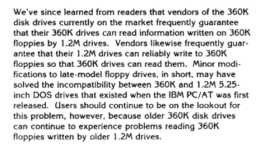Shadow Lord
Veteran Member
While doing a search for Quaid Disk Analyzer (prompted by this thread) I ran into this ad (left lower corner). It talks about a program that allows writing 360KB disks on a 1.2MB drive and have them remain readable on a 360KB drive. I am guessing the program purposefully adjust tracks to compensate for the narrower track width on the HD drives. Anyone have an experience with this and know how it worked?
Thanks.
Thanks.

